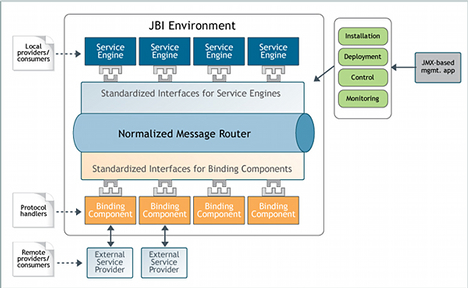Fuse 6 is no longer supported
As of February 2025, Red Hat Fuse 6 is no longer supported. If you are using Fuse 6, please upgrade to Red Hat build of Apache Camel.此内容没有您所选择的语言版本。
Chapter 1. Introduction to JBI
Abstract
Java Business Integration (JBI) defines an architecture for integrating systems through components that interoperate by exchanging normalized messages through a router.
Important
The Java Business Integration components of Red Hat JBoss Fuse are considered deprecated. You should consider migrating any JBI applications to OSGi.
The Java Business Integration (JBI) specification defines an integration architecture based on service-oriented concepts. Applications are divided into decoupled functional units. The functional units are deployed into JBI components that are hosted within the JBI environment. The JBI environment provides message normalization and message mediation among the JBI components.
The JBI environment is made up of the following parts, as shown in Figure 1.1, “The JBI architecture”.
Figure 1.1. The JBI architecture
- The JBI component framework hosts and manages the JBI components. For more information see Chapter 2, The Component Framework.
- The normalized message router provides message mediation among the JBI components. For more information see Chapter 3, The Normalized Message Router.
- The management structure controls the life-cycle of the JBI components and the functional units deployed into the JBI components. It also provides mechanisms for monitoring the artifacts that are deployed into the JBI environment. For more information see Chapter 4, Management Structure.
